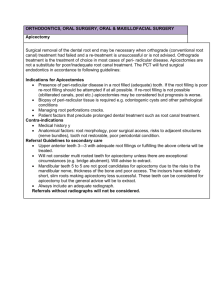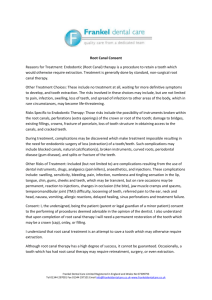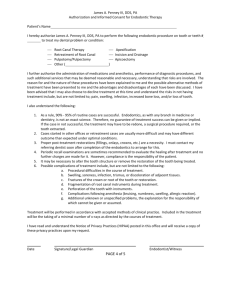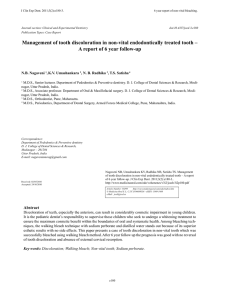Discolored (Intrinsically stained) teeth Etiology: Any tooth which is
advertisement
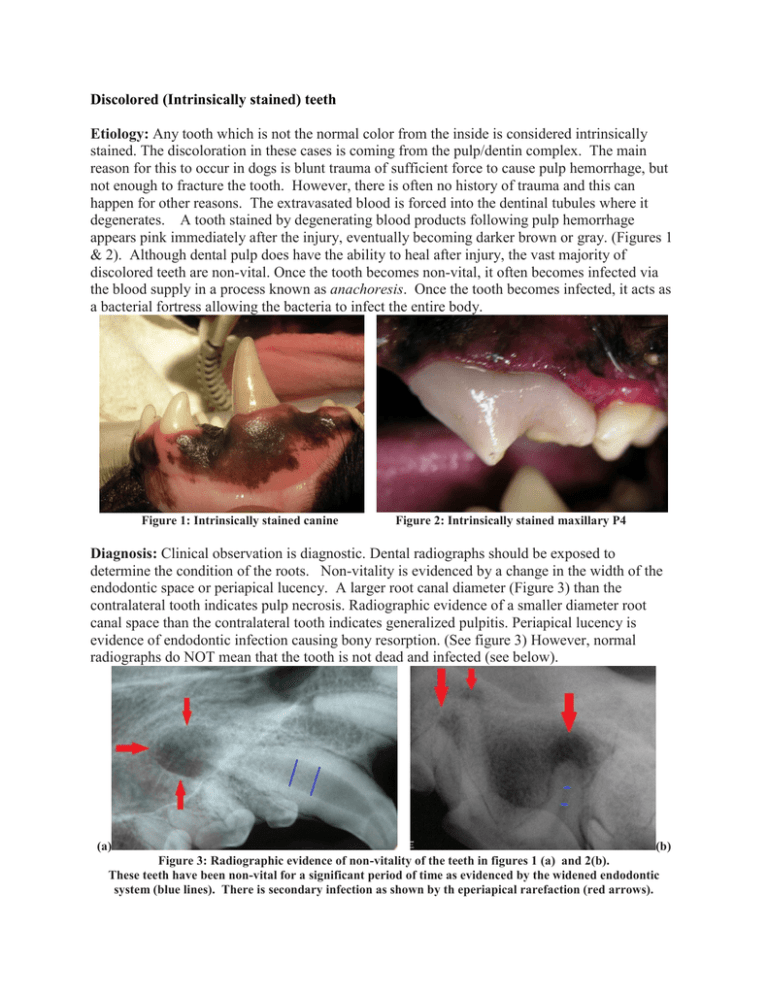
Discolored (Intrinsically stained) teeth Etiology: Any tooth which is not the normal color from the inside is considered intrinsically stained. The discoloration in these cases is coming from the pulp/dentin complex. The main reason for this to occur in dogs is blunt trauma of sufficient force to cause pulp hemorrhage, but not enough to fracture the tooth. However, there is often no history of trauma and this can happen for other reasons. The extravasated blood is forced into the dentinal tubules where it degenerates. A tooth stained by degenerating blood products following pulp hemorrhage appears pink immediately after the injury, eventually becoming darker brown or gray. (Figures 1 & 2). Although dental pulp does have the ability to heal after injury, the vast majority of discolored teeth are non-vital. Once the tooth becomes non-vital, it often becomes infected via the blood supply in a process known as anachoresis. Once the tooth becomes infected, it acts as a bacterial fortress allowing the bacteria to infect the entire body. Figure 1: Intrinsically stained canine Figure 2: Intrinsically stained maxillary P4 Diagnosis: Clinical observation is diagnostic. Dental radiographs should be exposed to determine the condition of the roots. Non-vitality is evidenced by a change in the width of the endodontic space or periapical lucency. A larger root canal diameter (Figure 3) than the contralateral tooth indicates pulp necrosis. Radiographic evidence of a smaller diameter root canal space than the contralateral tooth indicates generalized pulpitis. Periapical lucency is evidence of endodontic infection causing bony resorption. (See figure 3) However, normal radiographs do NOT mean that the tooth is not dead and infected (see below). (a) (b) Figure 3: Radiographic evidence of non-vitality of the teeth in figures 1 (a) and 2(b). These teeth have been non-vital for a significant period of time as evidenced by the widened endodontic system (blue lines). There is secondary infection as shown by th eperiapical rarefaction (red arrows). Management Discolored teeth are generally irreversibly inflamed or necrotic and should be treated with root canal treatment or extraction. Some will argue that the lack of radiographic changes indicates that the tooth has responded to the insult and is vital. However, we now know that radiographs are not very specific for diagnosing infected teeth. This is for several reasons: 40-60% of the bone must be lost before it is appreciated radiographically The endodontic system changes very gradually in older pets Animals have a very good immune system to keep infected teeth at bay. This has been shown in a 2001 study by Hale where only 40% of intrinsically stained teeth have radiographic signs of endodontic disease. However, when physically examined, 92.7% were non-vital and infected. In our experience (over 1000 cases), ALL discolored teeth are non-vital and infected. For larger teeth such as canines and carnassial teeth, root canal therapy is the treatment of choice. (Figure 4) For small teeth such as incisors and premolars, extraction is a viable alternative, but root canal therapy is also indicated if the client wishes to save the tooth. (a) (b) Figure 4: (a) extracted mandibular canine and maxillary P4 in a large breed dog demonstrating the size of the roots. (b) Post-operative root canal.

